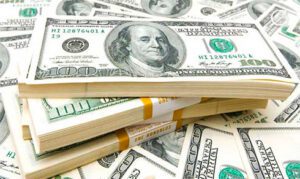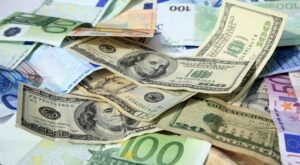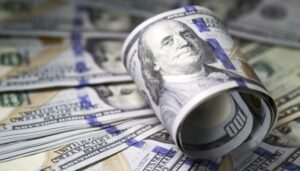
The dollar is moderately declining against the euro, but growing against the Japanese yen, renewing its maximum value in 24 years.
The ICE-calculated index, which shows the performance of the US dollar against six currencies (the euro, Swiss franc, yen, Canadian dollar, pound sterling and the Swedish krona), is practically unchanged on Wednesday morning, as is the broader WSJ Dollar.
The euro/dollar pair is trading at $0.9721 by 8:52 p.m. compared to $0.9707 at the close of the session on Tuesday, the euro adds about 0.1%.
Meanwhile, the rate of the American currency against the yen rose by almost 0.3% and amounted to 146.25 yen compared to 145.86 yen the day before. This is the highest rate since August 1998. The last time the yen fell to a 24-year low at the end of September, after which the Japanese Ministry of Finance intervened in the foreign exchange market to support the national currency.
The dollar is strengthening against the yen due to mixed monetary policy rates: while the Fed is actively raising interest rates, the Bank of Japan continues to adhere to extremely soft monetary policy.
The pound rose 0.4% to $1.1012 compared to $1.0968 at the close of the previous session.
Traders are evaluating conflicting signals about the Bank of England’s emergency government bond purchase program.
British Central Bank Chairman Andrew Bailey said that the regulator will complete the purchase of bonds on Friday, as planned. “The essence of interventions to stabilize financial markets is partly that this is a temporary phenomenon,” he said.
However, the Financial Times then wrote, citing three anonymous sources, that the Central Bank privately hinted to representatives of some banks about the possibility of extending the bond purchase program in order to protect UK pension funds from losses.

The US dollar is moderately declining against major world currencies on Thursday morning, investors evaluate the statements of the Federal Reserve Board and statistical data.
The ICE-calculated index, which shows the dynamics of the US dollar against six currencies (the euro, the Swiss franc, the yen, the Canadian dollar, the pound sterling and the Swedish krona), is down 0.2%, the broader WSJ Dollar is down 0.25%.
The euro/dollar pair is trading at $0.9920 by 9:08 Moscow time compared to $0.9885 at the close of the session on Wednesday, the euro adds about 0.35%.
The exchange rate of the American currency against the yen is reduced by 0.1% and amounts to 144.53 yen compared to 144.69 yen the day before.
The pound rose 0.1% to $1.1335 compared to $1.1327 at the close of the previous session.
The day before, the head of the Federal Reserve Bank of Atlanta, Rafael Bostic, said that he supports raising the key interest rate in the US by another 125 basis points by the end of the year, to 4.5%.
Meanwhile, San Francisco Fed colleague Mary Daly told CNN that the central bank should raise borrowing costs even higher and keep them high until inflation starts approaching 2%.
It became known yesterday that the index of business activity in the US services sector (ISM Non-Manufacturing) in September decreased to 56.7 points compared to 56.9 points a month earlier, data from the Institute of Supply Management (ISM) showed. Analysts, on average, assumed a more significant drop, to 56 points, according to Trading Economics.
Now all the attention of market participants is directed to data on the US labor market, which will be published on Friday. Experts believe that the unemployment rate in the country in September remained at the August mark of 3.7%, and the number of new jobs increased by 315 thousand people.

The dollar strengthens against the euro, yen and pound sterling in trading on Wednesday after a sharp decline the day before amid signals of a gradual decline in activity in the US economy.
Investors are waiting for data on the US labor market, which is expected to show a slowdown in job growth in the country. The consensus forecast of experts surveyed by Market Watch suggests that the number of jobs in September increased by 275 thousand (315 thousand in August), while maintaining unemployment at 3.7%.
The US Department of Labor will release the data on Friday at 3:30 p.m.
Another report from the Department of Labor, which was published on Tuesday, showed a sharp decrease in the number of open vacancies in the States in August. The indicator fell by 10% – the fastest pace since the start of the pandemic in 2020, to 10.1 million vacancies.
Weak statistics on the US economy are a good signal for risk appetite, as they speak in favor of a reduction in the trajectory of the Federal Reserve (Fed) rate hike, said Steven Innes, managing partner at SPI Asset Management.
Some “cooling” of the labor market will help ease inflation in the US and may reduce the need for further sharp tightening of monetary policy by the Fed, writes Dow Jones.
“If this trend continues, the Fed may back off somewhat in terms of rate hikes later this year and early next year,” said Jack Janasiewicz, portfolio manager at Natixis Investment Managers Solutions.
The euro/dollar pair is trading at $0.9966 on Wednesday, compared to $0.9987 at the close of previous trading. The pound fell to $1.1435 from $1.1475 at the close of previous trading.
The US dollar against the yen is 144.25 yen against 144.14 yen the day before.
On Tuesday, the dollar lost 1.7% against the euro, 1.4% against the pound and 0.3% against the yen.

The ICE-calculated index showing the dynamics of the dollar against six currencies (the euro, the Swiss franc, the yen, the Canadian dollar, the pound sterling and the Swedish krona) loses 0.11% during trading, the broader WSJ Dollar Index – 0.08%.
The euro/dollar pair is trading at $0.9846 compared to $0.9825 at the close of previous trading. The pound rose to $1.1361 compared to $1.1322 at the close of previous trading.
The US dollar against the yen is 144.75 yen against 144.56 yen the day before.
On Monday, the dollar lost 0.2% against the euro, 1.4% against the pound and 0.1% against the yen.
The weakening of the US currency was facilitated by statistical data showing a decrease in the index of business activity in the US manufacturing sector in September to the lowest level since May 2020. They were taken by the market as a signal that the Fed would have to stop the rate hike cycle earlier than expected in order to avoid a sharp decline in economic activity, Trading Economics notes.
The ISM Manufacturing Index fell to 50.9 last month from 52.8 a month earlier, according to the Institute for Supply Management (ISM). Analysts on average expected it to fall to 52.2 points, according to Trading Economics.
On Friday, September data on the US labor market will be released, which is expected to show a slowdown in US job growth. The consensus forecast of experts polled by Market Watch assumes an increase in the number of jobs in September by 275 thousand (315 thousand in August), while maintaining unemployment at 3.7%.
The dollar-denominated ICE index rose 7.2% in the third quarter, the biggest quarterly jump since 2015, according to Dow Jones data. In September, its value increased by 3.2%. The dynamics of the index for the whole of 2022 may be the best since 2014, when it grew by almost 13%.

The Japanese yen is depreciating against the US dollar on Monday morning.
The US dollar exchange rate against the yen at 8:56 am CST was 144.8 yen compared to 144.72 yen on Friday. During the session, the yen fell below 145 yen per $1, which could provoke the Japanese government to conduct foreign exchange intervention for the second time this year, writes Bloomberg.
The Japanese currency fell to 145.9 yen per dollar on September 22, after which the country’s Ministry of Finance decided to intervene in the foreign exchange market for the first time in 24 years. In total, authorities spent 2.84 trillion yen ($19.65 billion) in September to support the national currency, the ministry said.
The weakening of the yen comes against the backdrop of the Bank of Japan maintaining a loose monetary policy, while other central banks of the world have begun to tighten it due to inflation, beating multi-year records. In total, the yen has lost 21% since the beginning of the year.
“The yen is at risk of further depreciation as long as the BOJ’s yield curve control remains status quo and other central banks, including the Fed, continue to tighten or normalize policy,” said Oversea-Chinese Banking Corp. strategist. Christopher Wong.
Meanwhile, the ICE index, which shows the dynamics of the US dollar against six currencies (the euro, the Swiss franc, the yen, the Canadian dollar, the pound sterling and the Swedish krona), is down 0.27%, the broader WSJ Dollar is down 0.29%.
The euro/dollar pair is trading at $0.9822 compared to $0.9802 at the close of the session on Friday, the euro adds 0.2%.
The pound rose 0.7% to $1.1246 compared to $1.1168 at the close of the previous session.

The dollar is weakly strengthening against major world currencies on Thursday morning, investors are waiting for the results of the September meeting of the European Central Bank and evaluate the statements of members of the leadership of the Federal Reserve System.
The ICE-calculated index, which shows the dynamics of the US dollar against six currencies (the euro, the Swiss franc, the yen, the Canadian dollar, the pound sterling and the Swedish krona), is down 0.1%, the broader WSJ Dollar Index is up 0.1%.
The euro / dollar at 8:56 Moscow time is trading at $0.9996 compared to $1.0008 at the close of the previous session, the euro is losing about 0.1%.
The European Central Bank (ECB) is expected to raise key interest rates following the results of the September meeting immediately by 75 basis points (bp). The ECB has only once raised its base rate so sharply – a few days after the launch of the euro in 1999, but then it was a short-term technical adjustment, the Financial Times notes. The results of the meeting will be announced at 15:15 Moscow time on Thursday.
“There are no doves left in the ECB, only moderate and radical hawks,” said Katarina Utermeul, chief economist for European markets at Allianz SE.
The exchange rate of the American currency against the yen rose by 0.15% to 144.04 yen.
The yen has been the main casualty of the dollar’s recent rally as the Japanese currency is particularly sensitive to rising US long-term government bond yields, Investing.com writes.
“Any attempts to return to the 140 yen/$1 level have been short-lived, and in recent days the pair hit 144 yen/$1 for the first time since 1998,” wrote OANDA Senior Analyst Craig Erlam. to the dollar.”
The yen is under pressure from more hawkish comments from the Fed. Thus, the vice-president of the US Central Bank, Leil Brainard, said the day before that the Fed would have to raise the base interest rate to levels at which there would be a slowdown in economic activity.